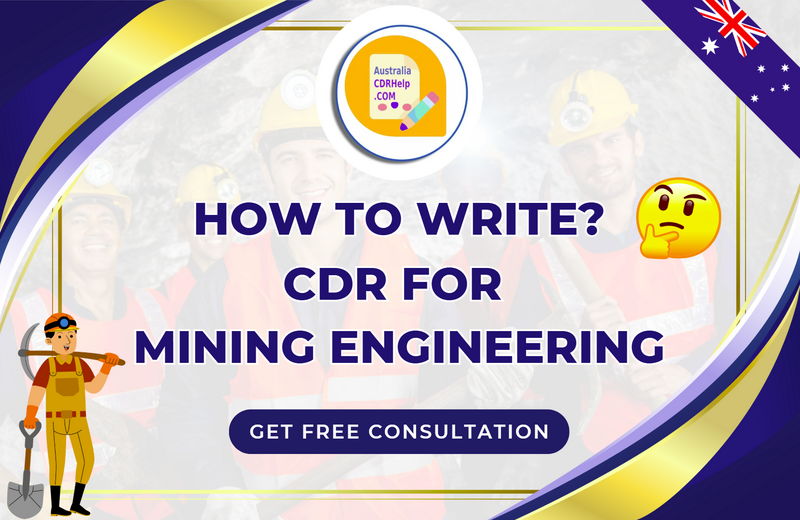Nominating the preferred occupational category for the CDR Assessment is critical for applicants. They are required to demonstrate their obtained engineering knowledge and competence in their practice area relevant to the nominated occupation. They need to showcase how they applied their knowledge and competency in the nominated occupational category through their CDR. A CDR, or competency demonstration report, helps candidates achieve skilled migration to Australia. Moreover, Engineers Australia conducts the migration skills assessment in the outlined occupational category to select the most suitable candidates for skilled immigration.
To be successful in CDR assessment, applicants need to create a comprehensive and compelling competency report that aligns with Engineers Australia guidelines. As a renowned and credible CDR services provider, AustraliaCDRHelp.com helps our clients craft premium reports, empowering them to succeed in skill assessments. We are allied with a panel of highly qualified, seasoned writers who know how to craft and design competency reports that impress the assessor and ensure a successful skills assessment. We always aim to help our clients obtain their desired objectives of Australian immigration. Leverage our services and take a step forward to success.
Nominate an Occupational Category for CDR Assessment
Engineers Australia outlines 4 Engineering Occupational Categories for migration purposes within the engineering practice in Australia.
Professional Engineer:
For professional engineers, the required academic qualification is a 4-year Bachelor of Engineering degree from a university following 12 years of schooling or equivalent education. Professional engineers undertake the following responsibilities:
- Take responsibility for projects and programs in the most far-reaching sense.
- Manage and focus on all systems.
- Apply systematic ways to the conduct and management of engineering projects.
- Apply management and leadership abilities.
- Apply established engineering techniques to complex engineering problems.
- Apply the systematic engineering synthesis and design process.
- Comprehend the need for clients, wide-ranging stakeholders and society as a whole.
- Comprehensively pursue engineering opportunities, taking environmental, community, and social issues into account.
Engineering Technologist:
For engineering technologists, the required academic qualification is an Australian 3-year Bachelor of Technology degree in engineering following 12 years of schooling or equivalent education. Engineering technologists undertake the following responsibilities:
- Operate under broadly-defined technical environments, and undertake a wide range of functions and responsibilities.
- Apply established engineering methods, techniques, tools and resources within the technology domain.
- Their expertise often lies in understanding the current state of development of a technology domain and the most recent applications of the technology.
- Comprehend practical conditions and applications, with the intellectual challenge of staying abreast of leading-edge developments and advancements as a specialist in a technology domain and how these relate to established practice.
- Responsible for engineering projects, services, functions and facilities under a technology domain, for particular interactions with other facets of an overall operating context and for handling the contributions of their specialist work to a broader engineering system or solution.
- Ensure that all facets of a technological product or operation are soundly grounded in theory and fundamental principles.
Engineering Associate:
For engineering associates, the required academic qualification is an Australian 2-year Advanced Diploma or Associate Degree in engineering, following 12 years of schooling or equivalent education. Engineering associates undertake the following responsibilities:
- Operate in accordance with codes and apply established practices and procedures.
- Emphasise specific elements of the systems.
- Provide technical support to construction managers and engineering professionals in research, design, manufacture, assembly, construction, operation and maintenance of machines and tools, facilities, distribution systems and installations.
- Prepare, interpret, inspect, and revise drawings, plans, diagrams, designs, maps and charts.
- Support in resource estimation and site inspection.
- Use advanced software tools to perform extensive design of structures, mechanical elements and systems, manufacturing or process plants, electrical and electronic equipment, information and communications systems, and so on.
Engineering Manager:
For engineering managers, the required academic qualification is a Bachelor’s degree or higher in engineering or an engineering-related field, following 12 years of schooling and equivalent education. Engineering managers generally undertake the following responsibilities:
- Determine, implement and monitor engineering strategies, policies and plans.
- Interpret plans, drawings and specifications, and advise on engineering techniques and procedures to achieve construction and production requirements.
- Ensure compliance with specifications, plans, laws, regulations, and safety standards.
- Responsible for the selection, training and development of personnel working for them.
- Responsible for planning, organising, directing, controlling and coordinating the engineering and technical operations of the organisation.
- Contribute to research and development projects.
Related Blog = How Long Does It Take For The Engineers Australia Assessment Fast Track?



